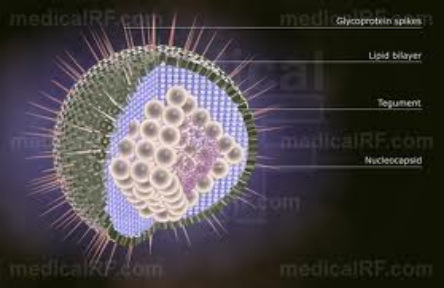Structure of Herpes Simplex Virus

This is the structure of a Herpes Simplex Virus. It is constructed of four parts, including the Glycoprotein spikes, lipid bilayer, tegument, and nucleocapsid.
Glycoprotein spikes-These spikes attach to receptors. These spikes are known as ligands, which are ions or molecules attached to a metal atom by coordinate bonding. When they attach to their receptors they will then fuse and the virus enters the cell via receptor mediated endocytosis, a process by which cells internalize molecules by the inward budding of plasma membrane vesicles containing proteins with receptor sites specific to the molecule being internalized.
Lipid bilayer-is a thin membrane made of two layers of lipid molecules. These membranes are flat sheets that form a continuous barrier around cells.
Tegument-more commonly known as a viral matrix, is a cluster of proteins that lines the space between the envelope and nucleocapsid of many enveloped viruses.
Nucleocapsid-The capsid of a virus with the enclosed nucleic acid. The core structure of a virus, consisting of nucleic acid surrounded by a coat of protein.
Glycoprotein spikes-These spikes attach to receptors. These spikes are known as ligands, which are ions or molecules attached to a metal atom by coordinate bonding. When they attach to their receptors they will then fuse and the virus enters the cell via receptor mediated endocytosis, a process by which cells internalize molecules by the inward budding of plasma membrane vesicles containing proteins with receptor sites specific to the molecule being internalized.
Lipid bilayer-is a thin membrane made of two layers of lipid molecules. These membranes are flat sheets that form a continuous barrier around cells.
Tegument-more commonly known as a viral matrix, is a cluster of proteins that lines the space between the envelope and nucleocapsid of many enveloped viruses.
Nucleocapsid-The capsid of a virus with the enclosed nucleic acid. The core structure of a virus, consisting of nucleic acid surrounded by a coat of protein.
